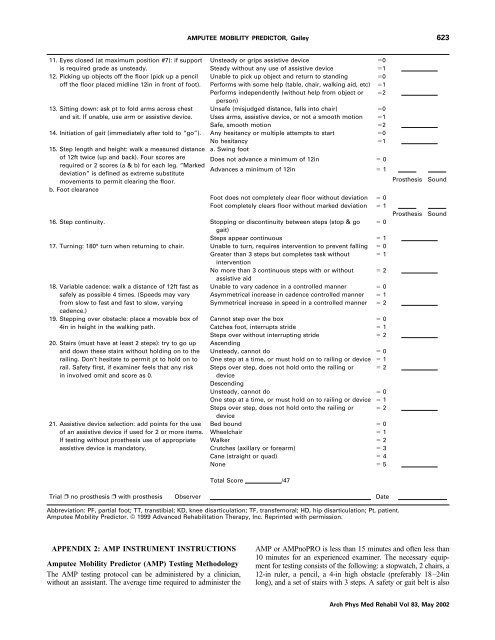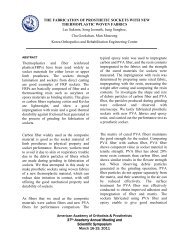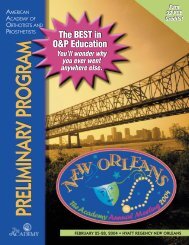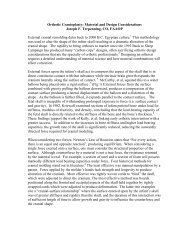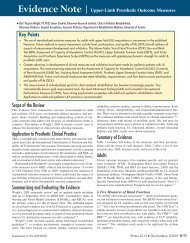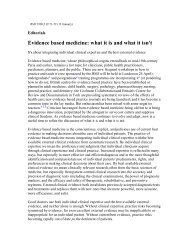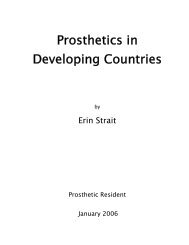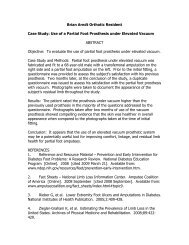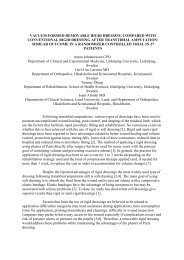The Amputee Mobility Predictor: An Instrument to Assess ...
The Amputee Mobility Predictor: An Instrument to Assess ...
The Amputee Mobility Predictor: An Instrument to Assess ...
Create successful ePaper yourself
Turn your PDF publications into a flip-book with our unique Google optimized e-Paper software.
11. Eyes closed (at maximum position #7): if support Unsteady or grips assistive device �0<br />
is required grade as unsteady.<br />
Steady without any use of assistive device �1<br />
12. Picking up objects off the floor (pick up a pencil Unable <strong>to</strong> pick up object and return <strong>to</strong> standing �0<br />
off the floor placed midline 12in in front of foot). Performs with some help (table, chair, walking aid, etc) �1<br />
Performs independently (without help from object or<br />
person)<br />
�2<br />
13. Sitting down: ask pt <strong>to</strong> fold arms across chest Unsafe (misjudged distance, falls in<strong>to</strong> chair) �0<br />
and sit. If unable, use arm or assistive device. Uses arms, assistive device, or not a smooth motion �1<br />
Safe, smooth motion �2<br />
14. Initiation of gait (immediately after <strong>to</strong>ld <strong>to</strong> “go”). <strong>An</strong>y hesitancy or multiple attempts <strong>to</strong> start �0<br />
No hesitancy �1<br />
15. Step length and height: walk a measured distance a. Swing foot<br />
of 12ft twice (up and back). Four scores are Does not advance a minimum of 12in � 0<br />
required or 2 scores (a & b) for each leg. “Marked<br />
deviation” is defined as extreme substitute<br />
Advances a minimum of 12in � 1<br />
movements <strong>to</strong> permit clearing the floor.<br />
b. Foot clearance<br />
Prosthesis Sound<br />
Foot does not completely clear floor without deviation � 0<br />
Foot completely clears floor without marked deviation � 1<br />
Prosthesis Sound<br />
16. Step continuity. S<strong>to</strong>pping or discontinuity between steps (s<strong>to</strong>p & go<br />
gait)<br />
� 0<br />
Steps appear continuous � 1<br />
17. Turning: 180° turn when returning <strong>to</strong> chair. Unable <strong>to</strong> turn, requires intervention <strong>to</strong> prevent falling � 0<br />
Greater than 3 steps but completes task without<br />
intervention<br />
� 1<br />
No more than 3 continuous steps with or without<br />
assistive aid<br />
� 2<br />
18. Variable cadence: walk a distance of 12ft fast as Unable <strong>to</strong> vary cadence in a controlled manner � 0<br />
safely as possible 4 times. (Speeds may vary Asymmetrical increase in cadence controlled manner � 1<br />
from slow <strong>to</strong> fast and fast <strong>to</strong> slow, varying<br />
cadence.)<br />
Symmetrical increase in speed in a controlled manner � 2<br />
19. Stepping over obstacle: place a movable boxof Cannot step over the box � 0<br />
4in in height in the walking path.<br />
Catches foot, interrupts stride � 1<br />
Steps over without interrupting stride � 2<br />
20. Stairs (must have at least 2 steps): try <strong>to</strong> go up Ascending<br />
and down these stairs without holding on <strong>to</strong> the Unsteady, cannot do � 0<br />
railing. Don’t hesitate <strong>to</strong> permit pt <strong>to</strong> hold on <strong>to</strong> One step at a time, or must hold on <strong>to</strong> railing or device � 1<br />
rail. Safety first, if examiner feels that any risk Steps over step, does not hold on<strong>to</strong> the railing or � 2<br />
in involved omit and score as 0.<br />
device<br />
Descending<br />
Unsteady, cannot do � 0<br />
One step at a time, or must hold on <strong>to</strong> railing or device � 1<br />
Steps over step, does not hold on<strong>to</strong> the railing or<br />
device<br />
� 2<br />
21. Assistive device selection: add points for the use Bed bound � 0<br />
of an assistive device if used for 2 or more items. Wheelchair � 1<br />
If testing without prosthesis use of appropriate Walker � 2<br />
assistive device is manda<strong>to</strong>ry.<br />
Crutches (axillary or forearm) � 3<br />
Cane (straight or quad) � 4<br />
None � 5<br />
APPENDIX 2: AMP INSTRUMENT INSTRUCTIONS<br />
<strong>Amputee</strong> <strong>Mobility</strong> <strong>Predic<strong>to</strong>r</strong> (AMP) Testing Methodology<br />
<strong>The</strong> AMP testing pro<strong>to</strong>col can be administered by a clinician,<br />
without an assistant. <strong>The</strong> average time required <strong>to</strong> administer the<br />
AMPUTEE MOBILITY PREDICTOR, Gailey<br />
Total Score /47<br />
Trial ❐ no prosthesis ❐ with prosthesis Observer Date<br />
Abbreviation: PF, partial foot; TT, transtibial; KD, knee disarticulation; TF, transfemoral; HD, hip disarticulation; Pt, patient.<br />
<strong>Amputee</strong> <strong>Mobility</strong> <strong>Predic<strong>to</strong>r</strong>. © 1999 Advanced Rehabilitation <strong>The</strong>rapy, Inc. Reprinted with permission.<br />
623<br />
AMP or AMPnoPRO is less than 15 minutes and often less than<br />
10 minutes for an experienced examiner. <strong>The</strong> necessary equipment<br />
for testing consists of the following: a s<strong>to</strong>pwatch, 2 chairs, a<br />
12-in ruler, a pencil, a 4-in high obstacle (preferably 18–24in<br />
long), and a set of stairs with 3 steps. A safety or gait belt is also<br />
Arch Phys Med Rehabil Vol 83, May 2002


